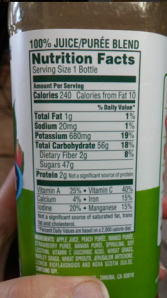Food Science in the News - Information is Power
Nutritional Outlook recently posted an article describing the results of a test on different Front of Pack label formats. The International Food Information Council (IFIC) Foundation conducted a study in which they gave consumers four different packages, quizzed them on the nutrient amounts, and asked them which labeling system they preferred. Here were the options, excerpted from the Nutritional Outlook article (full article here):
"The study asked participants to look at four different packages, each featuring a nutrition facts panel as well as a unique FOP label:
1) a control version without any nutrition information on the FOP,
2) an FOP listing calories only,
3) an FOP listing calories plus nutrients to limit, and
4) an FOP listing calories, nutrients to limit, as well as nutrients to encourage.
After looking at these labels, participants were asked to identify the nutrient amounts and percent daily values per serving in each product, rate the ease at which they were able to answer those questions, and pick which product was the best choice nutritionally."
*SPOILER ALERT* the fourth option won. The key here is not just providing the information, but also answering the question, "What am I supposed to do with this information?" Information is almost always useless without context.
If you haven't heard this story yet, give it time. This is just the type of story that mass media loves to jump all over-- a new tool to help consumers with their food choices, combined with the right amount of fear-tactics.
The Environmental Working Group (EWG, not to be confused with Eric Will Gymnastics aka my second home) recently published a food database which contains a scoring system for nutrition, ingredients of concern, and degree of processing. Every product in the database has an overall score, which consumers can use to find "greener, healthier and cleaner food choices." A database like this is a phenomenal tool with the potential to help consumers identify smarter choices for themselves and their families.
HOWEVER, anytime a database involves a rating system, it must also have specific criteria to remove the gray areas for assigning a one score or another. Case in point, how would you rate a vegetable smoothie that has 47g of sugar and contains ingredients with inherently high heavy metal counts (think seaweed) and pathogenic bacterial contamination (think leafy greens and E coli)? What metrics do you use to weight the severity of the "ingredients of concern"? Any ingredient also found in a yoga mat is obviously toxic, but what about salt? Sugar? Caffeine? For the degree of processing ranking, what about raw milk and the dangers associated with it's lack of processing?
I urge you to read the short rebuttal to the EWG ratings system from the Grocery Manufacturers Association (available here). A few of their most crucial points are excerpted below:
“The Environmental Working Group’s food ratings are severely flawed and will only provide consumers with misinformation about the food and beverage products they trust and enjoy. The methodology employed by EWG to develop their new food ratings is void of the scientific rigor and objectivity that should be devoted to any effort to provide consumers with reliable nutrition and food safety information. Their ratings are based almost entirely on assumptions they made about the amount, value, and safety of ingredients in the products they rate. Adding insult to injury, EWG conducted no tests to confirm the validity of any of their assumptions. Not only will the EWG ratings provide consumers with inaccurate and misleading information, they will also falsely alarm and confuse consumers about their product choices. Embedded in the ratings are EWG’s extreme and scientifically unfounded views on everything from low-calorie sweeteners to the nutritional value of organic foods.”
BOTTOM LINE
Information can be empowering, when provided in the right context. Watch out for fear tactics and overly simplified assumptions as to what constitutes "healthy food." As I tell myself every time I do a Risk Assessment for a new ingredient, CONSIDER THE SOURCE. Also, "keep an open mind, but not so open that your brain falls out."I Ate the Whole Thing - Food Label Renovation perspective
FACTS and Fear - how they influence consumer perception
The Dosage Makes the Difference - Lessons from the Father of Toxicology
Help us get to 50 Likes on Facebook! https://www.facebook.com/energydrinkguide
Schedule a 1-on-1 with the GreenEyedGuide on Google Helpouts

No comments:
Post a Comment